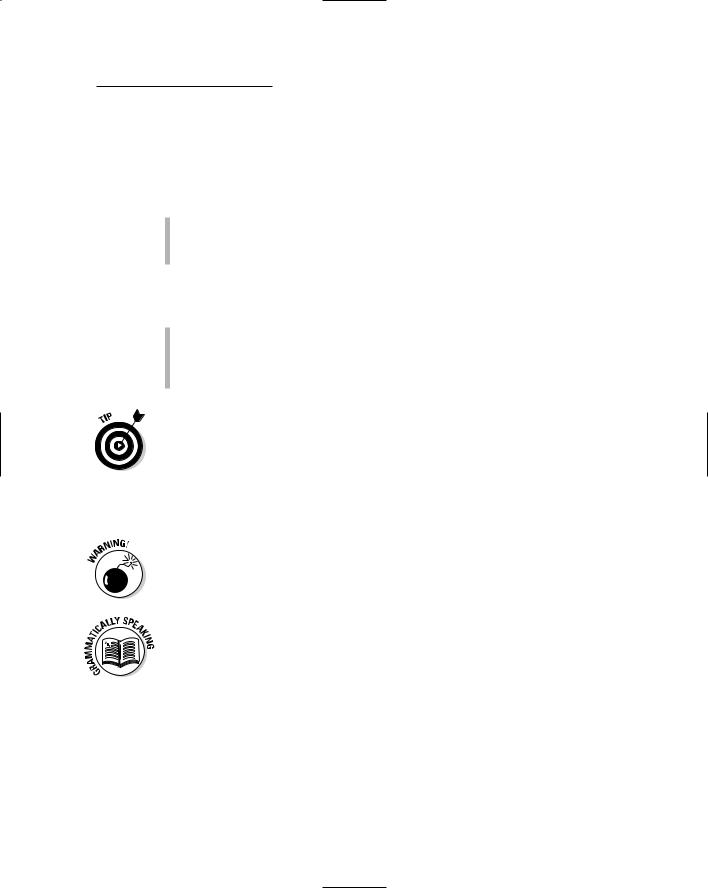
Russian For Dummies
.pdf
224 Part III: Russian on the Go
Words to Know
v komandirovku |
f kuh-muhn-dee-rohf-koo |
(to go) on a busi- |
|
|
ness trip |
Mnye nuzhna viza. |
mnye noozh-nah vee-zuh |
I need a visa. |
Vot dokumyenty. |
voht duh-koo-myen-tih |
Here are my |
|
|
documents. |
chyek na 150 dollarov |
chyek nuh stoh pee-dee- |
check for $150 |
|
syat doh-luh-ruhf |
|
My nye prinimayem |
mih nee pree-nee-mah- |
We do not accept |
|
eem |
|
tol’ko |
tohl’-kuh |
only |
Pridyotsya pridti |
pree-dyot-sye preet-tee |
(I) will have to |
yesh’yo raz. |
ee-sh’yo rahs |
come again. |
Take It with You: Packing Tips
When your trip is quickly approaching, it’s time to start packing. No matter when and where you travel, you most likely take the following with you:
chyemodan (chee-mah-dahn; suitcase)
sumka (soom-kuh; bag)
ryukzak (ryuk-zahk; backpack)
karta (kahr-tuh; map)
fotooapparat (fuh-tuh-uh-puh-raht; camera)
plyonka (plyon-kuh; film)
vidyeo kamyera (vee-dee-uh kah-mee-ruh; video camera)
mylo (mih-luh; soap)
shampun’ (shuhm-poon’; shampoo)
dyeodorant (deh-uh-dah-rahnt; deodorant)

Chapter 11: Planning a Trip 225
zubnaya sh’yotka (zoob-nah-ye sh’yot-kuh; toothbrush)
zubnaya pasta (zoob-nah-ye pahs-tuh; toothpaste)
kosmyetika (kahs-mye-tee-kuh; makeup)
If you’re going to Russia during the winter months, be prepared! Here are items of clothing you want to take with you to keep warm:
shapka (shahp-kuh; hat)
pal’to (puhl’-toh; heavy coat or overcoat)
sharf (shahrf; scarf)
pyerchatki (peer-chaht-kee; gloves)
svityer (svee-tehr; sweater)
sapogi (suh-pah-gee; boots)
Chapter 6 has more info about different items of clothing that you can pack, regardless of the season when you’re traveling.

226 Part III: Russian on the Go
 Fun & Games
Fun & Games
Find Russian equivalents for the American-style dates given in the left column.
Check out Appendix C for the correct answers.
1.12/01/2005 a. pyervoye dyekabrya dvye tysyachi pyatogo goda
2.01/03/1999 b. vosyem’nadtsatoye maya tysyacha dyevyatsot
shyest’dyesyat vtorogo goda
3. 05/18/1962 c. dvadtsat’ vtoroye syentyabrya tysyacha dyevyat’sot pyat’dyesyat shyestogo goda
4. 09/22/1956 d. tryet’ye yanvarya tysyacha dyevyatsot dyevyanosto dyevyatogo goda
Which of the following places of interest is not located in St. Petersburg? See
Appendix C for the answer.
1.Piskaryovskoye kladbish’ye
2.Novodyevich’ye kladbish’ye
3.Ermitazh
4.Russkij muzyej

Chapter 12
Getting Around: Planes,
Trains, and More
In This Chapter
Moving along with motion verbs
Making your way through the airport
Exploring public transportation
Traveling by train
As the Russian proverb has it, Yazyk do Kiyeva dovyedyot (ee-zihk dah kee-ee-vuh duh-vee-dyot), which translates as “Your tongue will lead you
to Kiev,” and basically means, “Ask questions, and you’ll get anywhere.” With the help of this chapter, you’ll be able to ask your way into the most wellconcealed corners of the Russian land via several different modes of transportation. And you’ll definitely be able to make it to Kiev!
Understanding Verbs of Motion
Every language has a lot of words for things the speakers of that language know well. That’s why the Eskimos have 12 different words for “snow.” Russians have a lot of space to move around; maybe that’s why they have so many different verbs of motion.
In English, the verb “to go” can refer to walking, flying by plane, or traveling by boat (among other options). That’s not the case in Russian; in fact, for one very simple and straightforward English infinitive “to go,” Russian has several equivalents. Each of these verbs has its own (and we should say, very erratic) conjugation pattern.
Your choice of verb depends on many different factors and your intended message. To mention just a few factors, the choice depends on

228 Part III: Russian on the Go
Whether the motion is performed with a vehicle or without it
Whether the motion indicates a regular habitual motion
Whether the motion takes place at the moment of speaking
Why does Russian have so many words to indicate movement? Having this distinction helps make a message clearer and even saves time on unnecessary questions. For example, when you say “I want to go to the theater tonight” in English, it’s not quite clear whether you’re going to drive, walk, or take a train, and so the listener may have to ask for additional information, such as “How are you going to get there?” or “Will you drive?” In Russian, this information is already packed into your answer, depending on the verb that you use. Your verb choice eliminates the need to ask additional questions and may save the listener a lot of time. Neat, isn’t it?
In the following sections, we explain the verbs of motion to use when you’re speaking of habitual or present movement. We also show you how to talk about the exact places you’re going.
Going by foot or vehicle habitually
To talk about moving around generally, you use the multidirectional verbs khodit’ (khah-deet’; to go on foot) and yezdit’ (yez-deet’; to go by vehicle). If you’re talking about walking around the city or driving around the country, these two verbs are the ones to use.
You also use the multidirectional verbs khodit’ and yezdit’ when you talk about repeated trips there and back, such as ya khozhu v shkolu (ya khah- zhoo f shkoh-loo; I go to school) and on yezdit na rabotu (ohn yez-deet nah ruh-boh-too; he goes to work by vehicle).
These two verbs indicate regular habitual motion in the present tense. As an example of how to use these verbs, think of places that you go to once a week, every day, two times a month, once a year, or every weekend. Most folks, for example, have to go to work every day. In Russian you say:
Ya khozhu na rabotu kazhdyj dyen’ (ya khah-zhoo nuh ruh-boh-too kahzh-dihy dyen’; I go to work every day) if you go by foot
Ya yezzhu na rabotu kazhdyj dyen’ (ya yez-zhoo nuh ruh-boh–too kahzh-dihy dyen’; I go to work every day) if you go by vehicle
The verb khodit’ is conjugated in Table 12-1.

Chapter 12: Getting Around: Planes, Trains, and More 229
Table 12-1 |
Conjugation of Khodit’ |
|
Conjugation |
Pronunciation |
Translation |
ya khozhu |
ya khah-zhoo |
I go on foot |
|
|
|
ty khodish’ |
tih khoh-deesh’ |
You go on foot (informal singular) |
|
|
|
on/ona/ono khodit |
ohn/ah-nah/ah-noh |
He/she/it goes on foot |
|
khoh-deet |
|
my khodim |
mih khoh-deem |
We go on foot |
|
|
|
vy khoditye |
vih khoh-dee-tee |
You go on foot (formal singular and |
|
|
plural) |
|
|
|
oni khodyat |
ah-nee khoh-dyet |
They go on foot |
|
|
|
When you talk about walking, you also can use the expression khodit’ pyeshkom (khah-deet’ peesh-kohm; to go by foot, to walk). This expression sounds redundant, but that’s the way it’s used in Russian.
The verb yezdit’ is conjugated in Table 12-2.
Table 12-2 |
Conjugation of Yezdit’ |
|
Conjugation |
Pronunciation |
Translation |
ya yezzhu |
ya yez-zhoo |
I go by vehicle |
|
|
|
ty yezdish’ |
tih yez-deesh’ |
You go by vehicle (informal |
|
|
singular) |
on/ona/ono yezdit |
ohn/ah-nah/ah-noh |
He/she/it goes by vehicle |
|
yez-deet |
|
|
|
|
my yezdim |
mih yez-deem |
We go by vehicle |
|
|
|
vy yezdite |
vih yez-dee-tee |
You pl. go by vehicle (formal |
|
|
singular and plural) |
|
|
|
oni yezdyat |
ah-nee yez-dyet |
They go by vehicle |
|
|
|
You also can specify the vehicle you’re using with one of these phrases:
yezdit’ na taksi (yez-deet’ nah tuhk-see; to go by taxi)
yezdit’ na marshrutkye (yez-deet’ nah muhr-shroot-kee; to go by minivan)
yezdit’ na avtobusye (yez-deet’ nah uhf-toh-boo-see; to go by bus)
yezdit’ na myetro (yez-deet’ nah mee-troh; to go by metro)

230 Part III: Russian on the Go
yezdit’ na poyezdye (yez-deet’ nah poh-yeez-dee; to go by train)
yezdit’ na mashinye (yez-deet’ nah muh-shih-nee; to go by car)
Going by foot or vehicle at the present time
In Russian, your word choice depends on whether you’re moving around generally (such as driving around the city or walking around your house) or purposefully moving in a specific direction or to a specific place. To talk about moving around generally, you use the multidirectional verbs khodit’ and yezdit’, which we discuss in the previous section.
You use different verbs (called unidirectional verbs) to specify that you’re moving in a specific direction or to a specific place. You also use these verbs to indicate motion performed at the present moment.
For walking, use the verb idti (ee-tee; to go in one direction by foot), such as in the phrase Ya idu na rabotu (ya ee-doo nuh ruh-boh-too; I am walking to work). Here’s the conjugation of idti:
Ya idu (yah ee-doo; I am going)
Ty idyosh’ (tih ee-dyohsh’; You are going; informal singular)
On/on/ono idyot (ohn/ah-nah/ah-noh ee-dyot; He/she/it is going)
My idyom (mih ee-dyom; We are going)
Vy idyotye (vih ee-dyo-tee; You are going; formal singular and plural)
Oni idut (ah-nee ee-doot; They are going)
For moving by a vehicle, use the unidirectional verb yekhat’ (ye-khaht’; to go in one direction by a vehicle):
Ya yedu (ya ye-doo; I am going)
Ty yedyesh’ (tih ye-deesh’; You are going; informal singular)
On/ona/ono yedyet (ohn/ah-nah/ah-noh ye-deet; He/she/it is going)
My yedyem (mih ye-deem; We are going)
Vy yedyetye (vih ye-dee-tee; You are going; formal singular and plural)
Oni yedut (ah-nee ye-doot; They are going)

Chapter 12: Getting Around: Planes, Trains, and More 231
Explaining where you’re going
To tell where you’re going specifically, use the prepositions v (v; to) or na (nah; to) + the accusative case of the place you’re going. See Chapter 15 for details on these particular prepositions:
Ya idu v tyeatr (ya ee-doo f tee-ahtr; I am going to the theater)
Ona idyot na kontsyert (ah-nah ee-dyot nuh kahn-tsehrt; She is going to the concert)
For walking or driving around a place, use the preposition po (pah; around) + the dative case (for more information on cases, see Chapter 2):
Ona khodit po Moskvye (ah-nah khoh-deet puh mahsk-vye; She walks around Moscow)
My yezdim po tsyentru goroda (mih yez-deem pah tsehnt-roo goh-ruh- duh; We drive around downtown)
Now the good news! As long as you’re moving within the city, you don’t need to make a distinction between going by vehicle and walking. Even if you change three modes of public transportation on the way to the library, you’re still perfectly fine saying ya idu v bibliotyeku (ya ee-doo v beeb-lee-ah-tye- koo; I’m going to the library). This distinction has remained in the language since the times when cities were small enough so that it was possible to walk everywhere. If you’re going out of town, however, it’s obvious that you need to use transportation, unless you’re prepared to walk for months.
Remember to use yezdit’ or yekhat’ (to go by vehicle) when you talk about going to other cities! Otherwise, if you say ya idu v Moskvu (ya ee-doo v mahsk-voo), you make it sound like you’re embarking on an enduring walking pilgrimage to Moscow, which is probably not your intention.
Sometimes Russians drop pronouns in sentences when using verbs of motion; it’s more conversational. For example, instead of Kuda ty idyosh’? (koo-dah tih ee-dyosh’; Where are you going?) you may hear simply Kuda idyosh’? (koo-dah ee-dyosh’; Where are you going?) And instead of saying Ya idu v tyeatr (ya ee-doo f tee-ahtr; I’m going to the theater), you may simply say Idu v tyeatr (ee-doo f tee-ahtr; I’m going to the theater).

232 Part III: Russian on the Go
Talkin’ the Talk
Sarah got a new job in Moscow. On the way to work, she meets her
Russian friend Kolya.
Sarah: |
Privyet! Kuda idyosh’? |
|
pree-vyet! koo-dah ee-dyosh’? |
|
Hi! Where are (you) going? |
Kolya: |
Na rabotu. Ya khozhu na rabotu pyeshkom kazhdyj |
|
dyen’. |
|
nuh ruh-boh-too. ya khah-zhoo nuh ruh-boh-too |
|
peesh-kohm kahzh-dihy dyen’. |
|
I’m going to work. I walk to work every day. |
Sarah: |
A ya yezzhu na myetro. Kolya, u tyebya yest’ plany |
|
na vyechyer? Davaj pojdyom v kino. |
|
ah ya ye-zhoo nuh mee-troh. koh-lye, oo tee-bya yest’ |
|
plah-nih nuh vye-cheer? duh-vahy pahy-dyom v kee- |
|
noh. |
|
And I go by metro. Kolya, do you have plans for |
|
tonight? Let’s go to the movies. |
Kolya: |
Syegodnya nye mogu. Idu s rodityelyami v tyeatr. |
|
see-vohd-nye nee mah-goo. ee-doo s rah-dee-tee-lee- |
|
mee f tee-ahtr. |
|
Tonight, I can’t. I’m going to the theater with my |
|
parents. |
|
|
Words to Know
U tyebya yest’ |
oo tee-bya yest’ |
Do you have plans |
plany na vyechyer? |
plah-nih nuh vye- |
for tonight? |
|
cheer |
|
Syegodnya nye |
see-vohd-nye nee |
Tonight, I can’t. |
mogu. |
mah-goo |
|
s rodityelyami |
s rah-dee-tee-lee-mee |
with my parents |

Chapter 12: Getting Around: Planes, Trains, and More 233
Navigating the Airport
Chances are, if you visit Russia, you enter by samolyot (suh-mah-lyot; plane). If not, you probably fly somewhere within the country during your visit — those 6.6 million square miles of land make air travel especially appealing. Whether you’re leaving Moscow for a 20-minute flight to St. Petersburg or a 9- hour flight to Vladivostok, the vocabulary you find in the following sections helps you plan and enjoy your trip by air.
Using the verb “to fly”
You use a special verb of motion when you talk about flying: lyetyet’ (lee-tyet’; to fly). You can’t use the verb yekhat’ (covered in “Going by foot or vehicle at the present time” earlier in this chapter) when you talk about traveling by plane, unless the plane is wheeling around the airport without actually leaving the ground. If the plane actually takes off, you have to use the verb lyetyet’, conjugated in Table 12-3.
Table 12-3 |
Conjugation of Lyetyet’ |
|
Conjugation |
Pronunciation |
Translation |
ya lyechu |
ya lee-choo |
I fly or I am flying |
|
|
|
ty lyetish’ |
tih lee-teesh’ |
You fly or You are flying (informal |
|
|
singular) |
|
|
|
on/ona/ono lyetit |
ohn/ah-nah/ah-noh |
He/she/it flies or |
|
lee-teet |
He/she/it is flying |
|
|
|
my lyetim |
mih lee-teem |
We fly or We are flying |
|
|
|
vy lyetitye |
vih lee-tee-tee |
You fly or You are flying (formal |
|
|
singular and plural) |
|
|
|
oni lyetyat |
ah-nee lee-tyat |
They fly or They are flying |
|
|
|
Checking in and boarding your flight
After you arrive at the aeroport (ah-eh-rah-pohrt; airport), you need to choose between the areas called zal prilyota (zahl pree-lyo-tuh; arrivals) and zal vylyeta (zahl vih-lee-tuh; departures). To inquire about the status of your flight, look at the informatsionnoye tablo (een-fuhr-muh-tsih-oh-nuh-ye tahb- loh; departures and arrivals display). Arrivals are called pribytiye (pree-bih- tee-ee) and departures are called otpravlyeniye (uht-pruhv-lye-nee-ee).
